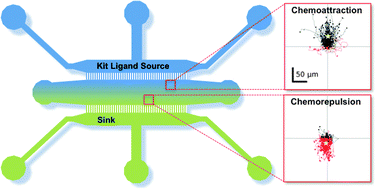Complex chemoattractive and chemorepellent Kit signals revealed by direct imaging of murine mast cells in microfluidic gradient chambers†
Abstract
Besides its cooperating effects on stem cell proliferation and survival, Kit

* Corresponding authors
a Department of Mechanical Engineering, Stanford University, USA
b Division of Hematology, Oncology, Stem Cell Transplantation, Stanford University, USA
c Department of Chemical Engineering, Stanford University, USA
d
Department of Materials Science and Engineering, Stanford University, 476 Lomita Mall, McCullough 246, Stanford, CA 94305-4045, USA
E-mail:
heilshorn@stanford.edu
Fax: +1 650-498-5596
Tel: +1 650-723-3763
Besides its cooperating effects on stem cell proliferation and survival, Kit

 Please wait while we load your content...
Something went wrong. Try again?
Please wait while we load your content...
Something went wrong. Try again?
 Fetching data from CrossRef.
Fetching data from CrossRef.
This may take some time to load.
Loading related content
